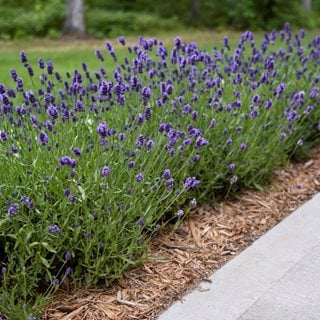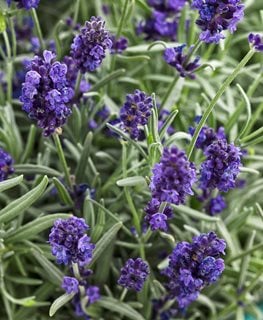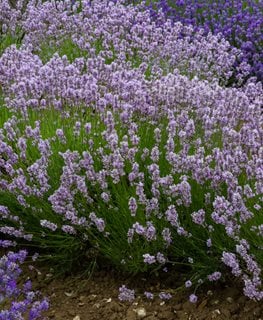Growing & Caring for English Lavender
Drinking in the aroma of English lavender on a warm, sunny day is one of the true pleasures of gardening. Get tips for planting, caring for, and preserving these intoxicating bloomers. Published 10/6/2022Although it hails from the Mediterranean, English lavender was so named because it has long been a staple in English herb gardens and is perfectly content growing in cooler climates. In addition to being one of the most cold-tolerant lavender varieties, it is also one of the most attractive. The soft gray-green foliage and dainty purple flowers make it a good companion for many other garden plants. And its airy, shrub-like form lends itself to both formal and informal settings.
“Gardeners who limit their use of English lavender to the herb garden should expand their thinking,” says Jeff Cox, author of Perennial All-Stars. “Few things are as pretty as a large swath of English lavender in full bloom.”
On this page: Basics | Planting | Care | Varieties | Harvesting & Preserving
- BASICS
- HOW TO PLANT ENGLISH LAVENDER
- ENGLISH LAVENDER CARE
- ENGLISH LAVENDER VARIETIES
- HARVESTING & PRESERVING ENGLISH LAVENDER
BASICS
Botanical name:
Lavandula angustifolia
Plant type:
Woody perennial
Zones:
5-9
Exposure:
Full sun
Size:
1 to 3 feet tall, 2 to 4 feet wide
Bloom time:
Early to late summer, with the blooms lasting 2 months or longer.
Foliage:
Narrow and lance-shaped, up to 2 1/2 inches long. Silvery to gray-green in color, remaining evergreen in warmer climates.
Flowers:
Typically shades of lavender or deep purple, although some cultivars have light pink or white blooms
Special attributes:
- Drought tolerant
- Intensely fragrant flowers and foliage
- Attracts bees and butterflies
- Rabbit and deer resistant
Toxicity:
Lavender contains a small amount of linalool, a compound that may be toxic to dogs and cats, according to the ASPCA, especially if ingested in large quantities.
PLANTING ENGLISH LAVENDER
Tip: Although English lavender will endure summer heat, it grows poorly in climates that have extremely hot, humid summers, preferring more temperate conditions. If you garden in the Deep South, consider planting Spanish lavender (Lavandula stoechas), which is more tolerant of high heat and humidity (see Common Types of Lavender).
When to plant:
In the spring after the soil has warmed up and the threat of frost has passed. If planting in the fall, give plants time for their roots to establish before winter.
Where to plant:
In a site that receives full sun (at least 6 hours daily) in loose, fast-draining, sandy soil. Avoid planting in heavy clay soils and in low spots prone to standing water. Because good drainage is essential, consider growing your plants in mounds, raised beds, or on slopes. A rock garden is also an excellent location for this drought-tolerant plant.
How to plant:
Lavender is often grown from nursery-started plants. Seeds do best when started with bottom heat, and may sometimes have low or erratic germination. Space plants about 2 to 3 feet part, depending on their width at maturity.
Growing in containers:
If your winters are harsh or your soil is heavy and dense, consider growing English lavender in containers in a high-quality potting mix with good drainage. In winter, bring your container plants indoors and place them in a sunny window where they will receive four to six hours of bright, direct sunlight daily. Learn more about how to grow lavender in pots.
ENGLISH LAVENDER CARE
Watering:
Thanks to its Mediterranean ancestry, English lavender is drought tolerant once established and only needs supplemental watering during prolonged dry spells. However, new plants should be watered regularly (every other day for the first week after planting, then once or twice a week until roots become established). Depending on your location, lavender may require some watering during winter, especially if in containers.
Tip: Watering English lavender too frequently can cause root and crown rot and is the most common reason plants die. For established plants, it’s best to err on the side of underwatering rather than overwatering.
Amendments and fertilizer:
Do not use any amendments, especially compost or other organic matter when planting. Plants grown in poor, sandy, or rocky soils will be healthier and longer-lived than those grown in humus-rich soil. Feeding is generally not necessary. Over-fertilized plants will often produce fewer flowers.
Pruning and deadheading:
Prune lavender back by 1/3 to 1/2 its height in spring after new leaves emerge to stimulate growth and keep plants from looking scraggly. Make the cuts just above the new leaf growth rather than cutting into the woody base, since lavender will not grow back from old wood. (The exception is dead or damaged stems, which should be removed right down to the base of the plant). Another light pruning in midsummer, right after the first flush of blooms, will often encourage repeat flowering. See more on pruning lavender.
Overwintering:
In climates where temperatures dip below zero degrees Fahrenheit, insulate your plants with a winter mulch of evergreen boughs, shredded leaves, or straw, especially if there’s a lack of snow cover. Proper soil drainage is also essential to plant survival in areas with cold, damp winters.
Propagation:
From stem cuttings taken from new growth in early summer.
Pests and diseases:
Lavender has few pest or disease problems, but is susceptible to Phytophthora root and crown rot, particularly if the soil around the base of the plant remains wet for long periods of time. Septoria leaf spot, a fungal disease that infects the surface tissues of the plant's leaves, can also be a problem. The best control measures are to avoid overhead watering and provide good air circulation around your plants.
ENGLISH LAVENDER VARIETIES
TIPS FOR HARVESTING & PRESERVING ENGLISH LAVENDER
In addition to its many culinary uses, English lavender is often harvested for both fresh and dried floral arrangements, sachets, and potpourris, making it a worthy addition to a cutting garden. To preserve the fragrance and color of your clippings, follow these harvesting tips.
- When harvesting English lavender for its scent: Cut when the flower buds are just beginning to show color, but before they are fully open. This is when the essential oils are at their peak.
- For fresh floral arrangements: Harvest flowers in the morning, after the dew has dried and before the afternoon heat sets in, by snipping the stems to the desired length just above a leaf node. Place the harvested blooms in a vase of water, removing all the leaves below the waterline.
- If harvesting for dried flowers: Tie the cut flower stalks into bunches and hang them upside down in a dry, well-ventilated space out of direct sunlight. Once dry (typically after a few weeks), you can strip off the dried buds and flowers to use for sachets or create a dried bouquet by leaving the flowers on the stems and arranging them upright in a vase.
- For the best color: Use English lavender varieties that have deep purple blooms for drying. They will hold their color longer than their pink- or white-flowered counterparts.
- If using the dried flowers for cooking: Remove them from the stems and store in jars, out of direct sunlight, for up to a year.














